| Article ID | Journal | Published Year | Pages | File Type |
|---|---|---|---|---|
| 201448 | Fluid Phase Equilibria | 2013 | 10 Pages |
•Adsorption of the fluorocarbon surfactant is hindered in the same way by the mixture of Tritons as the critical micelle concentration.•Tendency to adsorption of fluorocarbon surfactants from the mixtures is higher than from pure solutions.•Mixtures with FSN100 and FSO100 have two different values of CMC.
The values of the surface tension, density, viscosity, conductivity, pH and steady state fluorescence measurements were used for the determination of the surface and volumetric properties of the ternary mixtures composed of hydrocarbon (TX100, TX165) and fluorocarbon (FSN100, FSO100) surfactants. Using the surface tension data the composition of the mixed monolayer at the water–air interface and the activity of a particular component of the mixtures at this interface were calculated. From the measurements and calculations it appeared that adsorption of the fluorocarbon surfactant is hindered in the same way by the mixture of Tritons as the critical micelle concentration. Using different methods for the CMC determination of the studied systems, there can be obtained somewhat different values, which probably results from the sensitivity of a given method to the size and structure of the micelles. It also proved that above the second, higher value of CMC quenching mechanism becomes less effective which indicates the formation of less compact micelles and a decrease in micellar hydrophobicity. The composition of the mixed monolayers is quite different from that in the bulk phase and the fluorocarbon surfactant is enriched in this mixed monolayer but its total maximal adsorption is lower in comparison to that in the absence of the TX100 and TX165 mixture.
Graphical abstractValues of the mole fractions of the fluorocarbon surfactants (FSN100 and FSO100) in the ternary mixtures with TX100 and TX165 in the mixed monolayer at the water–air interface calculated without the water content and in the hypothetical mixture if they adsorb independently at the concentration of the added, third fluorocarbon surfactant equal to 5 × 10−6 M.Figure optionsDownload full-size imageDownload as PowerPoint slide
